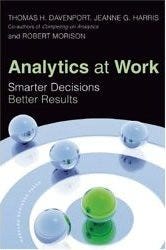In a preview of his follow-up to "Competing on Analytics," co-author and business guru Tom Davenport explores what it takes to move to analytic decision-making.

 The business best seller Competing on Analytics made the case that there are big rewards for organizations that embrace data-driven decision-making. Offering a preview of his soon-to-be-released follow-up, Analytics at Work: Smarter Decisions Better Results, co-author Thomas H. Davenport , professor of information technology and management at Babson College, recaps the book's five-stage "DELTA" model for assessing and improving analytical decision-making.
The business best seller Competing on Analytics made the case that there are big rewards for organizations that embrace data-driven decision-making. Offering a preview of his soon-to-be-released follow-up, Analytics at Work: Smarter Decisions Better Results, co-author Thomas H. Davenport , professor of information technology and management at Babson College, recaps the book's five-stage "DELTA" model for assessing and improving analytical decision-making.
What was the impetus for your new book, and why was a follow-up needed to Competing on Analytics?
I wrote the original "Competing on Analytics" article in 2006, and much to my astonishment it was the number-one reprint for Harvard Business Review that year. Then when Jeanne Harris and I released [the book] in 2007, it sold more than 100,000 copies and ended up being translated into 13 languages. Clearly the world wanted more on this topic, but we discovered that while many were interested in this idea of how you compete on analytical capabilities, there were a lot more people who said, "Our organization doesn't want to build its entire strategy around analytics, but we would like to become more analytical and make more analytical decisions." So Analytics at Work is a broader book on how you create and promote analytical capabilities even if you don't expect to be a Harrah's, Capital One, Progressive Insurance [or one of the other strategically analytic companies detailed in our first book].
"Analytics" is certainly becoming a big buzz phrase for vendors. But is developing analytic capabilities a matter of acquiring technology or does it have more to do with developing skills and expertise?
Technology is important, and it's good that it's increasingly available. But the book talks a lot more about the non-technical factors that go into developing analytical capabilities. Data, for instance, is closely intertwined with a lot of technical issues. But there are also a lot of data governance issues and challenges that aren't particularly technological. In our original research for Competing on Analytics, we found that the companies that are really good at analytics are doing a lot more than just buying technology from SAS or MicroStrategy or [SAP]BusinessObjects. You're starting to see that with the rise of services, as well. IBM and Accenture, for instance, have announced that they are building up their analytical consulting capabilities dramatically. So people certainly realized that it's not just a matter of technology.
What's your definition of analytics, and how would you distinguish them from business intelligence?
I think of analytics as a subset of BI based on statistics, prediction and optimization. The great bulk of BI is much more focused on reporting capabilities. "Analytics" has become a sexier term to use -- and it certainly is a sexier term than "reporting" -- so it's slowly replacing "BI" in many instances.
So how do companies develop statistics, prediction and optimization capabilities without hiring people who have been trained to do those things?
That's really tough, and that's why the "A" in our DELTA model is for "analysts." The key factor you find in companies that are really good at analytics is that they have a lot of really smart, analytical people. The companies that can attract those people -- whether they are from this country or other countries -- are going to be the ones that are most successful. There is also a fast-growing industry to outsource analytical capabilities to places like India, China and so on.
Some vendors say we can bake analytics into software and systems while others say that prebuilt analytics don't tend to yield innovation or competitive advantage. What's your stance on that debate?
There is a long-term trend toward what some describe as operational BI or the embedding of analytics into transaction systems. But even that is going to require smart people within your organization. You see it in companies that are putting in SAP Advanced Planning and Optimization (APO) and Supply Chain: Ultimately you may end up needing fewer people, but they have to be twice as smart. I don't think there's much doubt that to make analytics succeed, you're going to need smart people. You could argue that one of the reasons we got into trouble in this financial crisis is that we had all these automated systems for mortgages and so on and not enough people who could monitor them over time and explain them clearly to managers.  You mentioned the DELTA model, so let's get a quick summary of each of the letters in the acronym and a bit of the advice you offer in your book.
You mentioned the DELTA model, so let's get a quick summary of each of the letters in the acronym and a bit of the advice you offer in your book.
Data: It all starts with data, and not just because the DELTA acronym starts with "D." You can't do good, analytical decision-making unless you have decent data. Now everybody knows about the importance of data hygiene, making data accessible in a warehouse and so on. But the thing that is unique about our take on this topic is that we found that a number of companies that were really good at analytical decisions had developed distinctive and differentiating data sources. They either created that data themselves or they were the first to use it in their industry. Progressive Insurance, for example, was the first to use FICO scores for car insurance underwriting. Marriott developed a unique metric of hotel room profitability. Harrah's actually measures smiles for customer service analysis.
Enterprise: Whether you are talking about data or tools or people, our advice is to start taking an enterprise approach as opposed to the usual BI norm of having little pockets all around your organization that don't talk to each other or take a strategic approach. Companies that are good at taking an analytical approach are looking at things enterprisewide. P&G, for instance, has a group of [shared] analysts in an Information and Decision Solutions group. They take an enterprise approach to data because they could never connect supply and demand analytics if they treated those two things as isolated functional areas.
Leadership: This is the single most important thing, because if you have it, you can make all the other things happen. Rather than focusing on heroic CEOs, what we try to do in this book is focus on leaders at various levels who have managed to get analytical decision initiatives underway.
Targets: You can't be analytical about everything, so you have to figure out where it benefits your organization the most. For Harrah's, it was loyalty and service. For the great Boston Red Sox, it was finding the best players at the best price. For Wal-Mart, it was logistics. If you want a direct tie between analytical decisions and the bottom line, a lot of companies will find that pricing is the best way to do that.
Analysts: You definitely need smart people, but we talk about the different types of people you need and how you organize them. It's increasingly recognized that the companies that can hire and retain the best analysts are going to be the most successful at using data for better decisions. I just did a big study of analytics in retail, for example, and if you look at Wal-Mart or Target or JC Penney or other organizations that are doing really well, they all have a lot of really smart people.
I guess that's easy advice for a college professor to offer?
[Laughs] That's right; hire our graduates. Babson [College] tends to be a little more entrepreneurial in its orientation, but I'm trying to encourage a more analytical approach here, too.
Analytics at Work: Smarter Decisions, Better Results (Harvard Business Press, 2010) is co-authored by Tom Davenport, Jeanne Harris and Robert Morison.
About the Author(s)
You May Also Like







